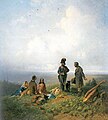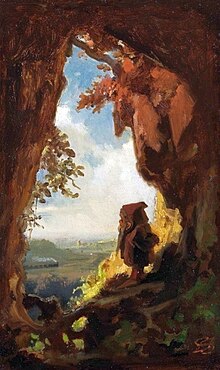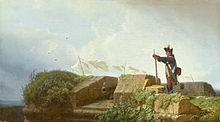Carl Spitzweg
Franz Carl Spitzweg (also outdated: Karl Spitzweg ; * February 5, 1808 in Munich ; † September 23, 1885 ibid) was a German painter and draftsman of the late Romantic period and the Biedermeier period .
Life
Childhood and youth
Carl Spitzweg was born on February 5, 1808 in Munich. His mother - Franziska Spitzweg (née Schmutzer) - belonged to the upper middle class of Munich as the daughter of a rich fruit wholesaler . The Schmutzers' estate at Neuhauser Gasse 14 was a stately property that Carl Spitzweg later gave through inheritance financial independence. Carl's father - Simon Spitzweg - came from the village of Unterpfaffenhofen near the town of Fürstenfeldbruck in what is today the Fürstenfeldbruck district (in Upper Bavaria ), where his family had grown rich. Until 1807, Spitzweg's father's business base was the trade in spices in Munich. His relatives ran flourishing fruit shops. Simon Spitzweg was an educated businessman who also gained respect and prestige in Munich through his political activities. Carl Spitzweg had two brothers whose occupations were just as predetermined by his father as his own. The oldest, Simon, was to take over the business, Carl was to become a pharmacist and the youngest, Eduard, was to become a doctor. Carl enjoyed a well-protected childhood in Munich. Due to the death of his mother in 1819, he became a half-orphan . In the same year the father married the sister of his late wife, Maria Kreszenz.
From 1819 Carl attended the university in Munich and passed the two Latin preparatory classes and the two Progymnasial classes with varying degrees of success; However, he left the actual grammar school, today's Wilhelmsgymnasium Munich , in 1824 after the second (of four) grammar school classes.
education
Although his artistic talent was announced early on (first drawing from 1823), Carl Spitzweg was obedient and began his apprenticeship in 1825 under Principal Franz Pettenkofer in the Royal Bavarian Court Pharmacy in Munich. On December 1, 1828, in Carl's last year of training, his father died.
In 1829 he worked in the Löwenapotheke in Straubing , where he spent a year with theater people and painters. In that year the eldest brother died as a merchant in Alexandria, Egypt.
Carl Spitzweg began studying pharmacy, botany and chemistry at Munich University in 1830, which he graduated with honors in 1832. He was now licensed as a practical pharmacist and worked as such a. a. also in the city pharmacy in Erding . In 1833 Spitzweg broke off his career as a pharmacist. During a spa stay in Bad Sulz ( Peißenberg ) after an illness, he made the decision to devote himself full-time to painting. The decision was made easier by the fact that he was assigned his inheritance share at that time.
In 1835 he became a member of the Munich Art Association. Carl Spitzweg never went to an academy, he was self-taught . This was followed by trips to Dalmatia (1839), Venice (1850) and with the landscape painter Eduard Schleich to Paris , London (for the first world exhibition ) and on the way back to Antwerp (1851), to Frankfurt am Main and Heidelberg .
From 1844 he worked for the Fliegende Blätter , which he provided with numerous humorous drawings.
Shortly after the death of his younger brother, Carl Spitzweg died of a stroke on September 23, 1885 at the age of 77 ; he was found leaning back in his chair in his Munich apartment. He was also buried in Munich.
plant
photos
Carl Spitzweg created over 1500 pictures and drawings. From 1824 he began to paint with oil paints . Spitzweg was able to sell around four hundred paintings during his lifetime. He found admirers and buyers above all in the citizens who had regained their purchasing power, although the popularity that Spitzweg's painting enjoys today did not begin until after the Second World War.
His style of painting belongs to the late romantic period . Initially, Spitzweg was still connected to the Biedermeier direction, later his painting style loosened up, very close to Impressionism . Spitzweg already drew a lot during his youth; During his work in the pharmacy, too, he drew the heads of the real and imaginary sick, young and old, as well as the originals of the small town of Straubing. What Spitzweg particularly liked about this idyllic town was the picturesque small townscape with its narrow streets and graceful bay windows, the turrets, fountains and stone figures. These motifs appear again and again in his pictures.
Spitzweg depicted people in their time-related bourgeois milieu. In small-format pictures, he depicts the Biedermeier petty bourgeoisie, the weird eccentrics and romantic events. To be sure, it represented human weaknesses, but not the wicked or the mean; all that was rough was alien to Spitzweg. The poor poet - Spitzweg's best-known and most popular picture - dates from 1839. In the picture The Cactus Lover , Spitzweg shows the office worker in front of his favorite plant, the cactus. Also worth mentioning in this context are paintings such as At the Antiquarian , Sentinel at the Gate , The Magician , The Alchemist , The Bookworm , A Visit , Farewell or The Beggar Musician .
Through his friendship with the landscape painter Eduard Schleich , with whom he traveled extensively, he became more aware of the landscape. With a sense of nature and color, he painted grandiose mountain ranges and their open space, romantic forest corners, the green plateau with forest, meadow and harvest field - mostly when the weather is nice; he preferred to depict the light. Am Ammersee , haymaking in the mountains and traveling people are examples.
Spitzweg had a strong sense of color. By training as a pharmacist, he gained chemical and technical experience in the manufacture of his paints. He used a unique, brightly shining blue that cannot be found in any other painter. He also knew how to produce permanent colors. From his long travels, Spitzweg brought home a rich collection of sketches that he added to his paintings in his studio.
Punch lines
Spitzweg developed the funny, sometimes ironic punch line as his specialty , which later often turned into an idyll. Among the most popular Spitzweg pictures are
- The poor poet : depiction of painterly poverty
- The Bookworm : Representation of a Book Scholar
- The intercepted love letter : Depiction of a romantic everyday scene
- Once upon a time (the knitting outpost) : an idle outpost in peacetime (the subject appears in two pictures)
- Where is the passport
Spitzweg made fun of many of the customs of his time. He also mocks the authorities with good-natured mockery, as in the picture in which a police officer asks driving musicians for their passports . Since the policeman speaks Franconian dialect, one of the musicians understands " bass " and points to the musical instrument.
- Hunting accident
A Sunday hunter from the city tripped over tree roots and slid down the slope. With his wig slipped, he hangs helplessly on the strap of his hunting bag and holds his rifle tightly. Spitzweg painted this mishap with glee by showing his eyes wide with terror, his right hand looking for support and the trousers stretched over his stomach.
- Disputing monks / quarreling hermits
The disputing monks are in a typical hermit environment. While one of the monks points to his document, the other takes a negative attitude and at the same time points to his mind. The quarreling hermits, on the other hand, seem to have little more to say to each other. At a great distance from each other, one points towards the sky, the other shows him a bird .
- The portrait painter (1843)
On the left, a man in a white apron is obediently following his master's gaze. He resigned to examine the portrait he had painted. He stands in front of his picture, the easel of which divides the picture space into two halves. On the right the model is enthroned on a pedestal. It is noticeable that the model is wearing a Spanish costume from the 17th century. This raises the question of whether portraits by the Flemish painters Frans Hals , Anthonis van Dyck or Rembrandt Spitzweg served as models. A bird watches curiously from the window sill. Sunlight falls into the studio through a large window.
A seemingly perfect artist idyll. The curious bird in the wide-open window symbolizes what appears to be unlimited freedom, which is not difficult to perceive, but the painter does not have this. In his small studio, the artist, stiffly and holding his hands to one side, looks at the emerging large portrait on the easel. There are also many paintings on the floor all around. As is often the case with Spitzweg's subtle storytelling, the idyll is deceptive. Because the artist seems at a loss on closer inspection. The model itself has no character traits that can be seen as Spanish. The artist has already tried his hand at various genres - religious painting, the art of portraits, genre painting - but obviously many of his works have remained unsold. The young artist was not happy with sales. Therefore, the plaster cast of the goddess of victory Nike was put on a fool's cap as a sign of her moodiness.
This painting has clear autobiographical traits. Spitzweg addresses his own attempts to sell his works, which were unsuccessful at the beginning of his career. On closer inspection, the name "Hanno [...]" can be deciphered on the large lid of a painting box leaning against the stove. This refers to the Hanover Art Association , through which Spitzweg, with varying degrees of success, tried to sell paintings on various occasions. In the specific case, Spitzweg had asked his agent Pichler to send the painting Bergschüler (Children in the Forest) to the art association in Hanover in order to sell it there. It can be identified in the foreground on the right. But with the “Bergschülern” - as with other works - he succeeded only with unsatisfactory success, especially in Hanover (where he had been in contact since 1838). Only after another unsuccessful attempt at the Rheinischer Kunstverein did the work find a buyer when it was later presented in Karlsruhe. The artist was obviously occupied with the failure in Hanover for many years. The painting History Painter in his studio can be seen as a “kind of accountability report for this dispute, which was only ended when another treasurer took over the administrative work”.
Idylls and landscapes
From 1859 until his death, Spitzweg occupied himself a lot with " small landscapes ", which he often painted on the boards of his cigar boxes. With increasing age, Spitzweg exaggerated his characters less caricaturally, but increasingly emphasized the idyllic.
- Hobbies
Spitzweg liked to characterize people with their hobbies. In the picture Der Kaktusfreund (The Cactus Friend ) an old, pipe-smoking gentleman in a dressing gown looks at his cactus, which has produced a flower. He had to wait a long time and is now quietly happy about it. Spitzweg is designing a peaceful place here, where nature and people come together in harmony.
In the case of cactus lovers , the thick cactus shows a red flower. A bald scribe, reddish knobbly nose and a high-necked skirt leans towards the cactus, which in turn leans towards it. Whether the shadows of the clock pendulum and the weights are shown correctly or incorrectly is debatable.
The butterfly hunter shows Spitzweg's ironic streak again. With strong glasses and a landing net that is too small, the hobby biologist stands pretty helplessly in the middle of a tropical forest, while two huge blue butterflies dangle around freely in the foreground. The viewer sees them, the more distant clumsy butterfly collector does not.
In the attic captures a scene in which a docile-looking man uses the opportunity to water his window flowers to watch a young neighbor doing housework at the open window, which she returns with a look.
The geologist shows an earth scientist working in the field, observing a handpiece.
- Idylls
Since the 1860s, Spitzweg has been intensively concerned with night pictures and created works such as The Serenade in the Moonlight or The Sleeping Night Watchman .
The blow tower in Schwandorf doesn't tell a story, but is a study of nature. The old tower rises up against the starry sky, and light shines from the upper window.
Blow tower in Schwandorf
Social criticism
Spitzweg's continued success to this day is undoubtedly based on the fact that he superficially shows an easily understandable, manageable world in his descriptions of petty-bourgeois, quirky behavior, which he also caricatures with wit and sagacity. His humor was profound and he often deeply and pessimistically criticized the grievances of his time. His paintings, which have so much strange things about them, do not show incomprehension, but rather his great understanding of human nature. They also reflect petty-bourgeois Biedermeier and revolutionary Vormärz at the same time.
Spitzweg was not only the popular painter-poet and satirical chronicler of the "good old days", the scenes of small-town life in the winding old town architecture. If social narrowness and restrictions prevail in a surveillance state, the citizen often withdraws to a private corner. Freedom of expression was considered very risky during Spitzweg's lifetime. For many it was advisable not to talk about politics if at all possible. Strict censorship banned newspapers and books, and many writings could only be published after compulsory corrections.
The painter's trick were his depictions of customs officials, guards, border guards and soldiers. His artistic interpretations on the subject of war are characteristic of Spitzweg. He does not paint dramatic or heroic scenes, but rather banal things and yawning, knitting or sleeping soldiers. In a humorous way, the painter set his sights on the petty bourgeoisie on the one hand, but also the scientific belief of his time and scholarship on the other. In his work, contrasts are revealed between the reality of the time and the prevailing classroom scholarship (example: art and science painted around 1880), between enthusiasm for nature and the remote nature of bourgeois reality ( Sunday walk 1841), between actual reality and mere theory ( The Alchemist , 1860s) . His “Justitia” ( Justice wakes up 1857) operates a battered scales of justice. The Metternich system also affected his art, although he had financially great artistic independence. To this day it is considered the epitome of the persecution and suppression of democracy, freedom of the press, freedom of expression and freedom of assembly.
The institute walk he painted in 1860 reveals, also in this regard, Spitzweg's artistic quality - a refreshing addition to the political landscape during his lifetime. In his artistic work, under the brooding summer sun, uniformed schoolgirls are guided through the landscape by watchful nuns "well protected". These also check that the gaze of the children and young people does not wander - from the “path of virtue” to the pair of lovers depicted or to the painting's rural society lying on the meadow. Only a dark-skinned girl dares to look at the lovers along the way. Also applicable to the present day, Spitzweg expresses state authority and surveillance - not only protective, but also explicitly threatening symbols of a repressive state. In his painting Justitia from 1857, a police officer - behind a statue of Justitias - observes the place for official announcements. This happens furtively in the picture and out of the shadow of a corner of the house.
Spitzweg also depicts the double standards of priests and hermits who indulge in drink and gluttony, who dream of erotic adventures and who chase after the female sex. He depicts the celibate barrier as easily surmountable. Spitzweg shows this, for example, in the painting Sennerin und Mönch from 1838 - clergymen in search of love adventures and sexual pleasure. Spitzweg leads the superficial picture viewer full of poetry into a seemingly innocent world, which, however, reveals ambiguity on questioning.
His “bookworm” (around 1850), Schopenhauer's remark “Everyone considers the end of his horizon to be that of the world”, as well as the “Poor Poet” painted by him, can be classified in this thematic area . A poet, removed from the orderly everyday life, found refuge in an attic, appears to him as a grotesque figure, as a unique and unfit for life.
Odd butterfly and bird catchers or the philistine as “Sunday hunters” are for him a picture full of comedy that subtly throws a spotlight on the “landed gentry” of his time, especially since the farmers suffered from the nobility's enthusiasm for hunting. Spitzweg offers opportunities for exciting discoveries, its idyll is deceptive and its joke exposes them.
Spitzweg also shows the dark side of supposedly idyllic small towns, where everyone sees and knows everything, so to speak. How this can turn into permanent observation and thus surveillance is evident in the picture of the well- wisher handing over a bouquet of flowers (The Eternal Wedding) (1872). Obviously there is no place of secrecy for the gentleman of the painting for his intimate confession of love. Around a dozen neighbors looking out of the windows or passers-by turning around in the alley transform the scene into a place of social control. His early work Der Trunkenbold (1836) and the drawing Der Bettler (around 1840/1845) both originated before the revolutionary year 1848. These prove Spitzweg not only as a psychologically sensitive interpreter of broken characters and unhappy existence, but also as a relentless commentator on social grievances. The sheet Im Putzmachersalon , created around 1835, is also to be understood as a criticism of existing conditions, because hypocrisy and double standards are presented here. With an assortment of hats and numerous boxes disguised merely as a milliner's shop , the establishment shown is in fact a brothel and bustling company. In contrast, Spitzweg's drawings for the critical weekly magazine Fliegende Blätter had explicitly political content . Especially before and after the coup years 1844-1852 this was his cycle guardroom fly . With Spitzweg, this socially critical and political aspect was not always noticed. Alois Elsen noted at an early stage: “One has deliberately overlooked the quiet warning, admonishing voice in such contributions to the 'Fliegende Blätter', and so the view prevailed that he did not have much of the goings-on of his fellow citizens in them critical years. [...] In reality, Spitzweg and the small society around him had placed all their hopes on the revolution that spread from Paris to Leipzig, Vienna and Munich without even achieving anything there. ”About Spitzweg's pronounced political interest his Viennese painter friend Moritz von Schwind (1804–1871) reported negatively in a letter in 1849 to Bernhard Skull . He called him a "politicizing painter", with which Schwind aimed at the circle of artists in Café Scheidel , which had been established and maintained by Spitzweg as early as 1840.
In general, Spitzweg, in many of his works, deals with the contradictions between the inner and outer world, between man and nature, although it cannot be proven that he dealt with these philosophical constructions in more detail.
In contrast to Spitzweg, the artists of the expressive Biedermeier period often adopted a conformist stance of silence in order to avoid repression. He met the then federal structures of an alleged separation of powers with irony and criticized existing injustice with coded strategies. Numerous works by Spitzweg reveal his mocking attitude towards the powers of the state, especially in connection with the enforcement organs, in the form of customs officers, guards or civil soldiers. Sometimes he exposes these protagonists - such as the flycatcher (1848) - in all their inadequacy. Even a banal gesture turns into an involuntary comedy. The unemployment of the many uniformed men - in the highly armed times, but without concrete military conflicts - provoked grotesque representations in him. Instead of weapons, the guard in Once Upon a Time (Der knitting Wach-posten ) (1850) holds knitting items. The military yawn with boredom, pass the time catching flies or are even caricatured in his pictures as if they were asleep while on guard duty.
Corruption is a theme in the picture work of the Papal Customs Guard (around 1855). While the officer is examining the luggage, a traveler slips him something, obviously to make him overlook an intended customs offense.
Presentation of technical innovations
An oil painting by him, which was created around 1848 on a wooden lid of a cigar box, shows a gnome looking at the steam train, which was new at the time. The old world of fairy tales and legends is contrasted with the new world of change and technical progress.
The German journalist, art dealer, art historian and book author Florian Illies describes the work as "perhaps the craziest painting by Spitzweg". Illies explores the question of whether Spitzweg's gnome, looking at the railroad, compared to the four years older painting Rain, Steam and Speed - the train of the "Great Western Railway" by William Turner is a step backwards, and answers her by saying that on the one hand the petty bourgeoisie become visible from Spitzweg's paintings. On the other hand, however, he masterfully caricatures his present "as a fairytale dwarf world [...] that believes that it can observe the comings and goings of modernity from its safe caves." Spitzweg is however thoroughly self-critical - the painter's perspective shows that his position finally lies deeper in the cave than that of the gnome. In a self-ironic way, Spitzweg commented on "his reputation as a Biedermeier Sunday painter who wanted to stop time."
Spitzweg's arrival in Seeshaupt (around 1880) shows a paddle steamer laid out on the quay of the very small town on Lake Starnberg. A larger group of travelers climbs the incline to the place, which seems to consist of only a few houses and the path on his painting that they are treading leads directly behind it into the mountains of the Alps. The steamboat skipper stands with a uniform cap on the upper deck of the ship and watches the hustle and bustle. This painting shows a tourist idyll.
The many discoveries and inventions during Spitzweg's lifetime stand for an "age of progress" in various fields of knowledge. He depicts the representatives of this period in paintings such as Der Chemikus (1855), Der Geologe (1865), Der Naturforscher in den Troppen (1835) ) and The Astrologer (1864). As a trained pharmacist, he in particular was open to new knowledge and the ideas of reality generated by science corresponded to his convictions. He was also enrolled at the University of Munich for chemistry, physics, botany, toxicology, zoology and mineralogy. Often in his scholarly representations - sometimes exaggerated to the quirky - reference is made to technical innovations. The illustrated telescope of the astrologer, for example, refers to the optical inventions of the physicist Joseph Fraunhofer and at the same time to the construction successes of Leonhard Späth in his hometown of Munich. Not only the conversations from natural history - that is the title of the major work by Gottlieb Tobias Wilhelm , was in Spitzweg's possession. It is also his interest in the humanities scholars who animate his works as philosophers, poets or librarians that strikes him.
- Exotic
On a trip to the world exhibition in London, Spitzweg got a little insight into the way of life of foreign peoples, which he immediately translated into pictures.
He implemented the life of the Jews without prejudice. The picture in the synagogue was inspired by Spitzweg's visit to the “ Old-New Synagogue ” in Prague . Unlike the disputing monks who quarrel in broad daylight, the synagogue lies in a mystical darkness in which devout Jews have gathered to study the holy scriptures.
Illustrations
Carl Spitzweg collected recipes, which he often provided with drawings or collages. For his niece Nina Spitzweg, he prepared a series of illustrated cooking recipes, which he said came from at least five cookbooks. Regarding the “ strawberry jam ”, he remarked: The same applies here as for the preparation of cherry jam . See this.
Herbal tea recipe
As a pharmacist, Spitzweg has dealt intensively with phytomedicine . He created various tea blends, including his famous five-herb tea, which the phytomedicist Christa Habrich discovered in old sources and presented on the occasion of an exhibition on the 125th anniversary of Spitzweg's death in the Medical History Museum in Ingolstadt in a contribution to the TV program Querbeet on BR TV . The ingredients of the tea are lavender , peppermint , quendel , rosemary , plus clove . In the Spitzweg painting “Der Blumenfreund” four of the five components of tea - lavender, peppermint, quendel and rosemary - are shown.
Poems
What is less well known is that Spitzweg was also active as a poet. Several of his letters have also been published. He himself described this second passion in several poems.
I as a poet
If I am already sacrificing the day
purely for pleasure,
I at least want to make a little pleasure for myself in the evening
.
I ask, you just have to give
up all pain here ;
Because on the day I paint,
and in the evening I do poetry. [...]
When Spitzweg received the Bavarian Order of Michael in 1865 , he immediately wrote a mocking poem about it:
The medals
When someone gets a medal,
it's the custom with us,
everyone says straight to his face:
"I would have deserved it too!"
This is truly gratifying,
there is a true picture!
How tall must the nation stand
where everyone feels that way !!
List of images (selection)
| image | title | year | Size / material | Exhibition / collection / owner / notes |
|---|---|---|---|---|

|
Self portrait | 1832 | 9.5 × 9.5 cm, drawing on paper | Private collection |

|
The poor poet | 1839 | 38 × 45 cm, oil on canvas | Neue Pinakothek, Munich, gift of the nephew |

|
The butterfly hunter | 1840 | 31 × 25 cm, oil on panel | Wiesbaden Museum |

|
The forbidden way | circa 1840 | 38.3 x 31.2 cm | |

|
Sunday stroll | 1841 | 53.2 × 41.3 cm, oil on panel | Museum Carolino Augusteum , Salzburg |

|
The hermit in front of his hermitage | 1844 | 30.5 × 34.5 cm, oil on canvas | Städelsches Kunstinstitut , Frankfurt am Main |

|
The Sunday Hunter | around 1845 | 40 × 33 cm, oil on canvas | State Gallery Stuttgart |

|
English in the Campagna | around 1845 | 40 × 50 cm, watercolor | Old National Gallery , Berlin |

|
Gnome looking at railroad | around 1848 | 24.0 × 14.7 cm, oil on panel | Private collection in Franconia |
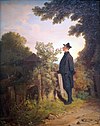
|
The rose friend | around 1847/1850 | 38.2 × 30.8 cm, oil on canvas | Städelsches Kunstinstitut, Frankfurt am Main |

|
The painter in a forest clearing, lying under an umbrella | around 1850 | 49.5 × 30.2 cm, oil on canvas | Privately owned |

|
The Bookworm | around 1850 | 49.5 × 26.8 cm, oil on canvas | Georg Schäfer Museum , Schweinfurt; two other copies with almost identical motifs are in the Grohmann Museum in Milwaukee or in private ownership. |

|
Street in Venice | around 1850 | 31.5 × 16 cm, oil on panel | Old National Gallery, Berlin |

|
The good bye | 1855 | Oil on canvas | Bavarian State Painting Collection, Munich |
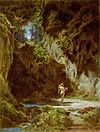
|
Bathing nymph | around 1855 | 54 × 40 cm, oil on canvas | Private collection in Dortmund |

|
A visit | around 1855 | 21.9 × 26.8 cm, oil on cardboard | Georg Schäfer Museum, Schweinfurt |

|
Turks in a coffee house | around 1855 | 52 × 41 cm, oil on canvas | Schack Gallery , Munich |

|
A solo (detail) | 1855 | 43 × 46 cm, oil on canvas | Private collection |
|
|
On the bastion | around 1856 | 21 × 49 cm, oil on canvas | Private collection |

|
The cactus friend | around 1856 | 54.3 × 32.2 cm, oil on canvas | Georg Schäfer Museum, Schweinfurt |

|
Spanish serenade | around 1856 | 67.8 × 53.4 cm, oil on canvas | Schack Gallery , Munich |

|
Justitia or Justice watches | around 1857 | 49 × 27 cm, oil on canvas | "Nazi looted art from Villa Hammerschmidt" |

|
The mail carrier in Rosenthal | around 1858 | 73.5 × 46.5 cm, oil on canvas | University Museum, Marburg |

|
Newspaper reader in the house garden | around 1845/1858 | 21.3 × 15.5 cm, oil on panel | Museum Pfalzgalerie Kaiserslautern |

|
Ash Wednesday | around 1855/1860 | 21 × 14 cm, oil on canvas | State Gallery Stuttgart |

|
The pastor as a cactus friend | around 1856 | 29 × 18 cm, oil on cardboard | Old National Gallery, Berlin |

|
Mowers in the mountains | around 1858 | 48 × 26.5 cm, oil on canvas | Private collection in Bavaria |

|
Austrian Guard Post (Austrian Customs House) | 1859 | 40 × 20 cm, oil on canvas | Old National Gallery, Berlin |

|
Landscape at the Ammersee | around 1860 | 15.7 × 32 cm, oil on panel | Privately owned |

|
The eternal wedding | around 1860 | 48 × 27.5 cm, oil on canvas | Villa Huegel , Essen |
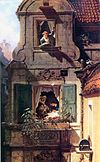
|
The intercepted love letter | around 1860 | 54.2 × 32.3 cm, oil on canvas | Georg Schäfer Museum, Schweinfurt |

|
Institute walk | around 1860 | 31.9 × 53.8 cm, oil on canvas | New Pinakothek , Munich |

|
The knitting outpost | around 1860 | 21.7 × 39.6 cm, oil on canvas | Georg Schäfer Museum , Schweinfurt, catalog raisonné 795 |

|
A hermit playing the violin | around 1862 | 31 × 54 cm, oil on canvas | Schack Gallery, Munich |

|
A hypochondriac | around 1865 | 54 × 31 cm, oil on canvas | New Pinakothek, Munich |

|
Old tavern on Lake Starnberg | 1865 | 32 × 54 cm, oil on canvas | Old National Gallery, Berlin |
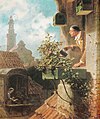
|
The attic | around 1865/70 | 30 × 23 cm, oil on cardboard | Wittelsbacher Compensation Fund , Munich |

|
Bavarian mountain landscape | around 1870 | 64.6 × 78.7 cm, oil on canvas | New Pinakothek, Munich |

|
Old monk in front of the hermitage | around 1870 | 19.3 × 30.7 cm, oil on canvas | Georg Schäfer Museum, Schweinfurt |

|
Yawning monk (meditation) | around 1870 | 54.5 × 32.5 cm, oil on canvas |
Wallraf-Richartz-Museum & Fondation Corboud
(WRM Dep. 0283) On loan from the Federal Republic of Germany since 1966 |

|
Reading Klausner | around 1870–79 | 24 × 16 cm, oil on panel | Old National Gallery, Berlin |

|
The night watchman fell asleep | around 1875 | 29 × 19 cm, oil on panel | Kurpfälzisches Museum , Heidelberg |

|
The sorcerer (also wizard and dragon ) | around 1875 | 29.8 × 21.9 cm, oil on canvas | Georg Schäfer Museum, Schweinfurt; an almost identical version in a larger format (47.1 × 26.2 cm) was returned to the descendants of the Jewish collector Leo Bendel in 2019. |

|
The post | around 1880 | 33 × 22 cm, oil on cardboard | Private collection |

|
Klausner | around 1880 | Oil on canvas | Riga Stock Exchange Art Museum, Riga, Latvia |

|
Art and science | around 1880 | 56.5 × 35 cm, oil on canvas | Private collection |

|
Papal Customs Guard | around 1880 | 37.5 × 30 cm, oil on panel | Municipal gallery in the Lenbachhaus , Munich |

|
Arrival in Seeshaupt | around 1880 | 68.9 × 49.8 cm, oil on canvas | Georg Schäfer Museum, Schweinfurt |

|
Kite flying | around 1880/1885 | 38 × 12 cm, oil on cardboard | Old National Gallery, Berlin |

- The caravan (around 1860; oil; 21.5 × 39.5 cm; Radolfzell City Museum)
- Pierrot and Columbine , also rendezvous (around 1875)
- Der Antiquar , also Der Bücherantiquar (around 1880), privately owned.
- Antiquarian and two girls (around 1855, not in the catalog raisonné, Switzerland, private collection)
- On the Alm (1880).
- The hussar
- The Commander
- meditation
- Only thoughts are duty free
- The serenade
- The Hagestolz
- The mineralogist Pforzheim gallery
- The friends of young people around 1855, Munich, Städtische Galerie im Lenbachhaus, Werksvereichniss 996
- Flute concert in the interior of the forest , Bonn, Federal President's Office, catalog raisonné 1069
- On the bastion (peacetime, yawning sentry) , Kunsthalle Mannheim , catalog raisonné 789
- Yawning sentry (on the bastion) , Munich, private property, not in the catalog raisonné
- Wachtposten , Braunschweig Städtisches Museum, catalog raisonné 793
- The cactus lover , Schäfer Schweinfurt Museum, catalog raisonné 899
- The rattle stork , around 1885, private property, catalog raisonné 500
- Peace in the country , around 1850/60 Munich, private property, not in the catalog raisonné
- Newspaper reader in the garden (politician in the little garden having coffee) , private collection, catalog raisonné 887
- The clergy's morning reading , 1847, Hanover, private property.
- The reading , around 1878/80 private property, not in the catalog raisonné
- Fishing monk with children , private property around 1855/60, not in the catalog raisonné
- Girls in the Mountains , Canada, Cape Georges, Ott Collection, not identical to catalog number 320
- Papal Customs Guard , Munich Lehnbachhaus, list of works 624
tomb
The tomb of Spitzweg is on the old southern cemetery in Munich (burial ground 5 - row 17 - Place 10/11) Location . The tombstone symbolizes an apothecary bottle. It is a replacement for the original tombstone that no longer exists.
Honors and reception
In his hometown Germering-Unterpfaffenhofen the Carl-Spitzweg-Gymnasium is named after him, in Munich the Carl-Spitzweg-Realschule. Several streets and paths in Germany bear his name, for example in Bergheim, Frankenthal (Pfalz), Goslar, Heidenheim an der Brenz, Leinfelden-Echterdingen, Pulheim, Schweinfurt, Stendal, Walldorf and Wesseling. In 1938 Spitzweggasse in Vienna-Hietzing was named after him. On the occasion of its 200th birthday, on February 7, 2008, Germany issued a special postage stamp and a 10 euro silver commemorative coin (mintage 1,760,000 pieces) with the motif “The poor poet”.
Max Barta , the Rübezahl vom Wartberg, worked as a copyist for Carl Spitzweg's works in the 20th century. The small court concert , a musical comedy in three acts, portrays the world of Carl Spitzweg. It is by Edmund Nick (music) as well as Paul Verhoeven and Toni Impekoven (libretto). The work consists of ten pictures that are based on Carl Spitzweg. “The poor poet” also appears as a figure in it.
Exhibitions
- 2003: Carl Spitzweg , House of Art , Munich
- 2017: Carl Spitzweg - Erwin Wurm. Delicious! Delicious? Leopold Museum , Vienna
- 2020: Carl Spitzweg , Kunst Museum Winterthur, Winterthur
literature
- Sigrid Bertuleit, Hans Joachim Neyer (eds.): Carl Spitzweg (1808–1885) and Wilhelm Busch (1832–1908). Two artist anniversaries. Catalog for the exhibition in the Georg Schäfer Collection, Schweinfurt 2008 and in the Wilhelm Busch Museum, Hanover 2009. Seemann, Leipzig 2008, ISBN 978-3-86502-193-9 .
- Max von Boehn : Carl Spitzweg. Bielefeld, Leipzig 1920.
- Richard Braungart , (introduction): Spitzweg's bourgeois humor with letters and anecdotes by the artist. Hugo Schmidt, Munich 1922.
- Johannes Glötzner: "... and in the evening I do poetry" - for Carl Spitzweg's 199th birthday. Edition Enhuber, Munich 2007, ISBN 978-3-936431-13-1 .
- Hyacinth Holland : Spitzweg, Carl . In: Allgemeine Deutsche Biographie (ADB). Volume 35, Duncker & Humblot, Leipzig 1893, pp. 226-230.
- Jens Christian Jensen : Carl Spitzweg. Paintings and drawings in the Georg Schäfer Museum, Schweinfurt. Prestel, Munich 2007, ISBN 978-3-7913-3747-0 .
- Jens Christian Jensen: Carl Spitzweg. Between resignation and criticism of time (= DuMont-Kunst-Taschenbücher. Vol. 26). DuMont Schauberg, Cologne 1975, ISBN 3-7701-0815-9 .
- Kristiane Müller, Eberhard Urban : Carl Spitzweg - Popular and unknown pictures along with drawings and studies supplemented by poems and letters, testimonials and documents. Unipart, 1995, ISBN 3-8122-3410-6 .
- Guenther Roennefahrt: Carl Spitzweg. Descriptive directory of his paintings, oil studies, and watercolors. Bruckmann, Munich 1960 (digitized: urn : nbn: de: bsz: 16-diglit-289698 ).
- Herbert W. Rott: Spitzweg, Franz Carl. In: New German Biography (NDB). Volume 24, Duncker & Humblot, Berlin 2010, ISBN 978-3-428-11205-0 , pp. 725-727 ( digitized version ).
- Wilhelm Rudeck (ed.): Philistines and owls to laugh. Pictures and words from Carl Spitzweg. Leipzig 1913.
- Lisa Schirmer: Carl Spitzweg. EA Seemann, Leipzig 1998, ISBN 3-363-00515-6 .
- Hans W. Schmidt: Carl Spitzweg, Illustrated Bibliography. Isensee, Oldenburg 2008, ISBN 978-3-89995-538-5 .
- Eugen Spitzweg (Hrsg.): The Spitzweg portfolio: excellent paintings by the master in copperplate reproduction. With a foreword by Friedrich Pecht. Munich 1887.
- Hermann Uhde-Bernays : Carl Spitzweg. The master's life and work; its importance in the history of Munich art. Delphin, Munich 1913 (first art historical monograph on Spitzweg, which became the basis of its wide recognition).
- Siegfried Wichmann , Christa Habrich : Carl Spitzweg, the painter and pharmacist. Nature and science in his work. For the exhibition in the German Medical History Museum Ingolstadt. Belser, Stuttgart 2003, ISBN 3-7630-2445-X .
- Siegfried Wichmann: Carl Spitzweg - directory of works. Paintings and watercolors. Belser, Stuttgart 2002, ISBN 3-7630-2395-X .
- Siegfried Wichmann: Carl Spitzweg - Traveling and hiking in Europe and the happy angle. Belser, Stuttgart 2002, ISBN 3-7630-2396-8 .
- Birgit Poppe: Spitzweg and his time. Seemann Henschel, Leipzig 2015, ISBN 978-3-86502-346-9 .
Web links
- Literature by and about Carl Spitzweg in the catalog of the German National Library
- Works by and about Carl Spitzweg in the German Digital Library
- Search for Carl Spitzweg in the SPK digital portal of the Prussian Cultural Heritage Foundation
- Works by Carl Spitzweg at Zeno.org .
- www.carl-spitzweg.de ( Memento from February 9, 2008 in the Internet Archive ) - Carl Spitzweg, life and work via Internet Archive
- Carl Spitzweg Catalog and exhibition in the Georg Schäfer Museum in Schweinfurt at www.cosmopolis.ch
- Pedigree of Carl Spitzweg at www.stephan-dorn.de
- Carl Spitzweg in HeidICON Illustrations of the flying leaves
- Entry on Carl Spitzweg's estate in the catalog of the Bavarian State Library
Individual evidence
- ↑ Christa Habrich, Wichmann Siegfried: Spitzweg, the painter and pharmacist: Nature and natural science in his work . Ed .: Christa Habrich. Belser, Stuttgart, ISBN 3-7630-2445-X , p. 12 .
- ↑ Annual report from the royal university in Munich. Volume 1824. Munich 1824, p. 27. (also previous and following)
- ↑ Max Biller: Peißenberger Heimatlexikon. 2., ext. Edition. 1984, p. 53.
- ^ Siegfried Wichmann: Carl Spitzweg. Art, Cost, and Conflict . Frankfurt a. M. / Berlin 1991, pp. 36-61. - Carl Spitzweg. List of works - paintings and watercolors . Stuttgart 2002, p. 268, VMS no. 511
- ↑ https://www.pinakothek.de/kunst/carl-spitzweg/der-institutsspaziergang
- ↑ https://www.nzz.ch/feuilleton/spitzweg-und-wurm-in-wien-situationskomik-und-zeitkritik-im-dialog-ld.1298638
- ↑ http://www.altertuemliches.at/files/sw_katalog_hpw.pdf
- ↑ http://www.altertuemliches.at/files/sw_katalog_hpw.pdf
- ↑ Florian Illies: KUNSTMARKT: »Gnom, Eisenbahn viewing«: On April 5th, perhaps the craziest painting by Spitzweg will be auctioned »My favorite painter? Carl Spitzweg, of course! «EDMUND STOIBER The former Bavarian Prime Minister may also appreciate Spitzweg because he painted pictures of the Transrapid route to Munich Airport in the 19th century . In: The time . March 27, 2008, ISSN 0044-2070 ( zeit.de [accessed January 14, 2020]).
- ↑ http://www.altertuemliches.at/files/sw_katalog_hpw.pdf
- ^ Gerhard Tötschinger : Would you like to dine? A culinary foray through the countries of the Austrian monarchy. Amalthea Verlag, 1996, ISBN 3-85002-384-2 , p. 139.
- ↑ Christa Habrich, Wichmann Siegfried: Spitzweg, the painter and pharmacist: Nature and natural science in his work . Ed .: Christa Habrich. Belser, Stuttgart, ISBN 3-7630-2445-X .
- ↑ a b Carl Spitzweg's five-herbal tea, accessed on January 29, 2017 ( Memento from February 22, 2011 in the Internet Archive )
- ↑ a b Müller / Urban: " Carl Spitzweg "
- ↑ https://www.sueddeutsche.de/muenchen/muenchen-villa-hammerschmidt-ns-raubkunst-verammlung-1.4779807
- ↑ Press release - Kunstsammlung Rudolf-August Oetker returns paintings by Carl Spitzweg to the descendants of the Jewish collector Leo Bendel , oetker-gruppe.de, November 20, 2019, accessed on December 20, 2019
- ↑ Jüdische Allgemeine: The company is returning another painting to the descendants of persecuted Jewish owners , juedische-allgemeine.de, November 20, 2019, accessed on December 20, 2019
- ↑ Federal Law Gazette 2008 Part I No. 3, issued in Bonn on January 25, 2008.
- ↑ hausderkunst.de: Carl Spitzweg
- ↑ leopoldmuseum.org: Carl Spitzweg - Erwin Wurm. Delicious! Delicious?
- ^ Carl Spitzweg ›Art Museum Winterthur. Accessed March 23, 2020 (Swiss Standard German).
| personal data | |
|---|---|
| SURNAME | Spitzweg, Carl |
| ALTERNATIVE NAMES | Spitzweg, Karl |
| BRIEF DESCRIPTION | Biedermeier painter |
| DATE OF BIRTH | February 5, 1808 |
| PLACE OF BIRTH | Unterpfaffenhofen |
| DATE OF DEATH | September 23, 1885 |
| Place of death | Munich |




